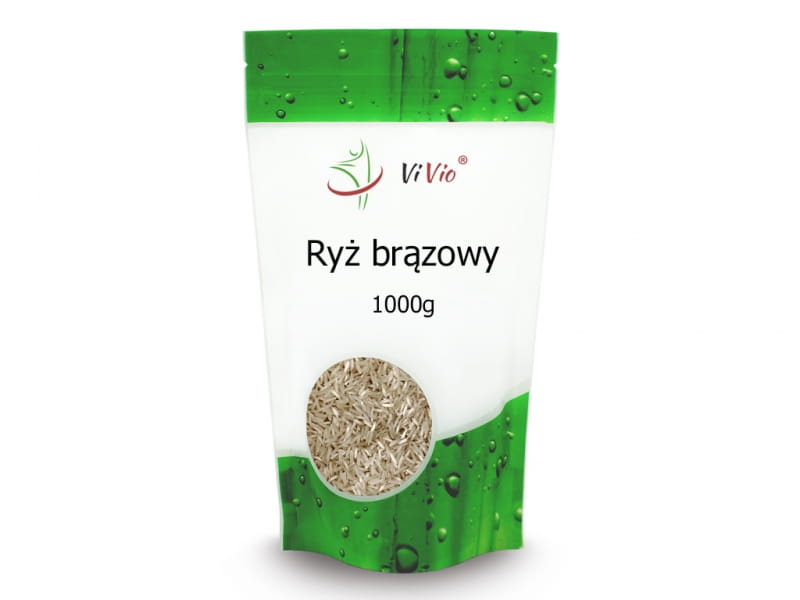Brown rice 1000g - VIVIO
- Regular price
- €3,78
- Regular price
-
- Sale price
- €3,78
- Unit price
- per
Couldn't load pickup availability
Description
xBrown rice was already cultivated in China 9,000 years ago. This plant was popular not only for its energy value and excellent taste, but also for the wealth of valuable nutrients for health. Brown rice is nothing more than a whole grain consisting of both the husk, endosperm and germ. In addition, this product is not subject to polishing and peeling processes. Compared to white rice, brown rice is characterized by less processing, greater hardness and longer cooking time. Also, this product requires a longer digestion time. It is also important to know that brown rice is characterized by higher levels of protein, fiber, vitamins, minerals and bioactive compounds compared to regular white rice. In addition, it is characterized by a lower glycemic index (IG = 50) , which allows the inclusion of small amounts in the diet of people struggling with the problem of insulin resistance. It is also important that brown rice is a gluten-free grain. Therefore, it can easily be used in the preparation of meals for patients with celiac disease or gluten intolerance and allergy.
Eating brown rice can provide our body with a number of valuable vitamins (including B vitamins ) - supports the proper functioning of the nervous system and vitamin E - the so-called vitamin of youth) and minerals (such as: magnesium, calcium, zinc, iron , potassium and phosphorus) . Although starch is the main ingredient in this product, it's important to know that brown rice is also rich in protein, which is easily digested by the human body. This product also contains valuable unsaturated fatty acids that support our immune system.
According to scientists, brown rice has powerful antioxidant properties. In addition, it can interfere with the proper functioning of liver enzymes. Research on this product has shown that incorporating brown rice into a balanced diet and active lifestyle can help reduce the risk of future hypercholesterolemia. In addition, brown rice supports our immunity and protects us from the harmful effects of viruses and bacteria (especially in the case of flu and colds) . Numerous scientific reports also point to the antidiabetic potential of this product. Eating brown rice does not cause your blood sugar levels to rise quickly like white rice does.
INGREDIENTS
Brown rice.
NUTRITIONAL VALUE OF THE PRODUCT IN 100 g
Calorific value - 1566 kJ / 370 kcal
fat - 1.9 g
- of which saturated fatty acids - 0.5 g
Carbohydrates - 76.8 g
- including sugar - 0.8 g
Fiber - 8.7 g
Protein - 7.1 g
Salt - 0.01 g
NET WEIGHT: 1000 g
APPLICATION
Brown rice is widely used in the kitchen. It can be a great addition to your dinner, as well as the basis for making a delicious snack. It's worth using when preparing nutritious stews or vegan stuffed cabbage. Brown rice cooked in milk with fresh fruit can be an excellent breakfast suggestion. However, the combination of cooked brown rice with apple and cinnamon turns out to be a great dessert offering for a fall afternoon.
Brown rice goes perfectly with poultry dishes. Also irreplaceable as an ingredient in exotic dishes.
Suggested preparation: Put rice in cold water (1 cup of rice to 2 - 2.5 cups of water). After the water boils, simmer for 30-35 minutes.
RECOMMENDED STORAGE
Store in a cool and dry place.
similar products
- Regular price
- €3,78
- Regular price
-
- Sale price
- €3,78
- Unit price
- per
- Regular price
- €3,78
- Regular price
-
- Sale price
- €3,78
- Unit price
- per
- Regular price
- €3,78
- Regular price
-
- Sale price
- €3,78
- Unit price
- per
- Regular price
- €3,78
- Regular price
-
- Sale price
- €3,78
- Unit price
- per
- Regular price
- €3,78
- Regular price
-
- Sale price
- €3,78
- Unit price
- per
- Regular price
- €3,78
- Regular price
-
- Sale price
- €3,78
- Unit price
- per
- Regular price
- €3,78
- Regular price
-
- Sale price
- €3,78
- Unit price
- per
- Regular price
- €3,78
- Regular price
-
- Sale price
- €3,78
- Unit price
- per
- Regular price
- €3,78
- Regular price
-
- Sale price
- €3,78
- Unit price
- per
- Regular price
- €3,78
- Regular price
-
- Sale price
- €3,78
- Unit price
- per
Recently Viewed Products
- Regular price
- €3,78
- Regular price
-
- Sale price
- €3,78
- Unit price
- per
- Regular price
- €3,78
- Regular price
-
- Sale price
- €3,78
- Unit price
- per
- Regular price
- €3,78
- Regular price
-
- Sale price
- €3,78
- Unit price
- per
- Regular price
- €3,78
- Regular price
-
- Sale price
- €3,78
- Unit price
- per
- Regular price
- €3,78
- Regular price
-
- Sale price
- €3,78
- Unit price
- per
- Regular price
- €3,78
- Regular price
-
- Sale price
- €3,78
- Unit price
- per
- Regular price
- €3,78
- Regular price
-
- Sale price
- €3,78
- Unit price
- per
- Regular price
- €3,78
- Regular price
-
- Sale price
- €3,78
- Unit price
- per
- Regular price
- €3,78
- Regular price
-
- Sale price
- €3,78
- Unit price
- per
- Regular price
- €3,78
- Regular price
-
- Sale price
- €3,78
- Unit price
- per
- Choosing a selection results in a full page refresh.











